MGMT6012: Case Study Analysis of Management Perspectives and Ethics
VerifiedAdded on 2022/12/03
|10
|2685
|432
Case Study
AI Summary
This case study report examines the ethical attitudes and practices of Woolworths, a major Australian retail company. The report analyzes the company's ethical considerations, including transparency, team building, supply chain management, and stakeholder engagement. It also addresses recent ethical discrepancies, such as supplier management issues and child labor scandals, highlighting the need for a thorough review of the company's ethical conduct. The research methodology proposed involves an interview method to gather primary data on employee perceptions of ethical codes. The analysis will employ both qualitative and quantitative approaches to present a comprehensive understanding of the organization's ethical situation. Furthermore, the report delves into Woolworths' ethical policies, which align with UN and ILO guidelines, focusing on human rights, anti-corruption, labor rights, and environmental compliance. The role of management functions (planning, directing, organizing, and controlling) in maintaining ethical guidelines is also discussed, along with the impact of social and political changes on organizational processes. The case study provides valuable insights into the challenges and complexities of maintaining ethical standards within a large organization and the importance of continuous monitoring and improvement.
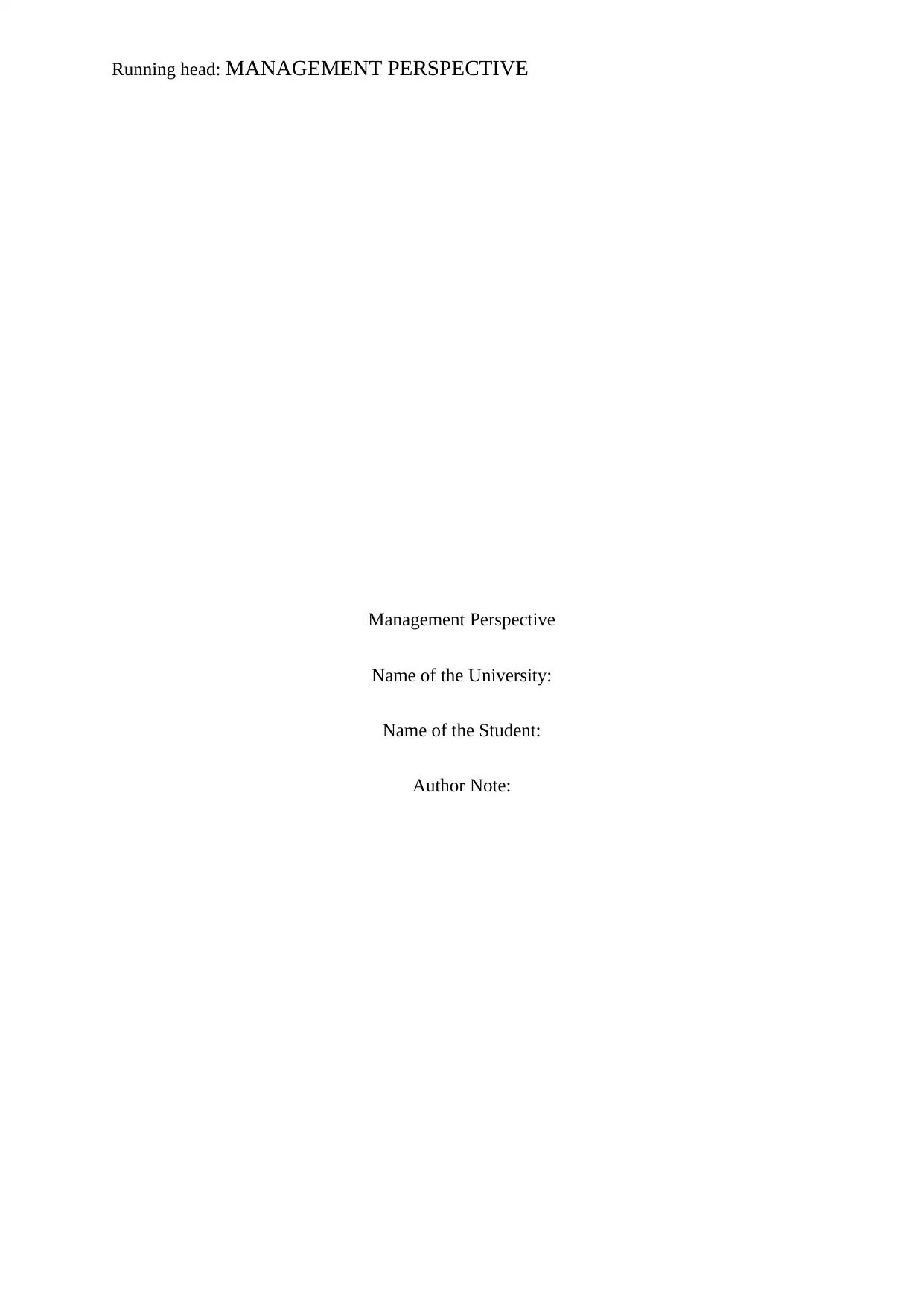
Running head: MANAGEMENT PERSPECTIVE
Management Perspective
Name of the University:
Name of the Student:
Author Note:
Management Perspective
Name of the University:
Name of the Student:
Author Note:
Paraphrase This Document
Need a fresh take? Get an instant paraphrase of this document with our AI Paraphraser
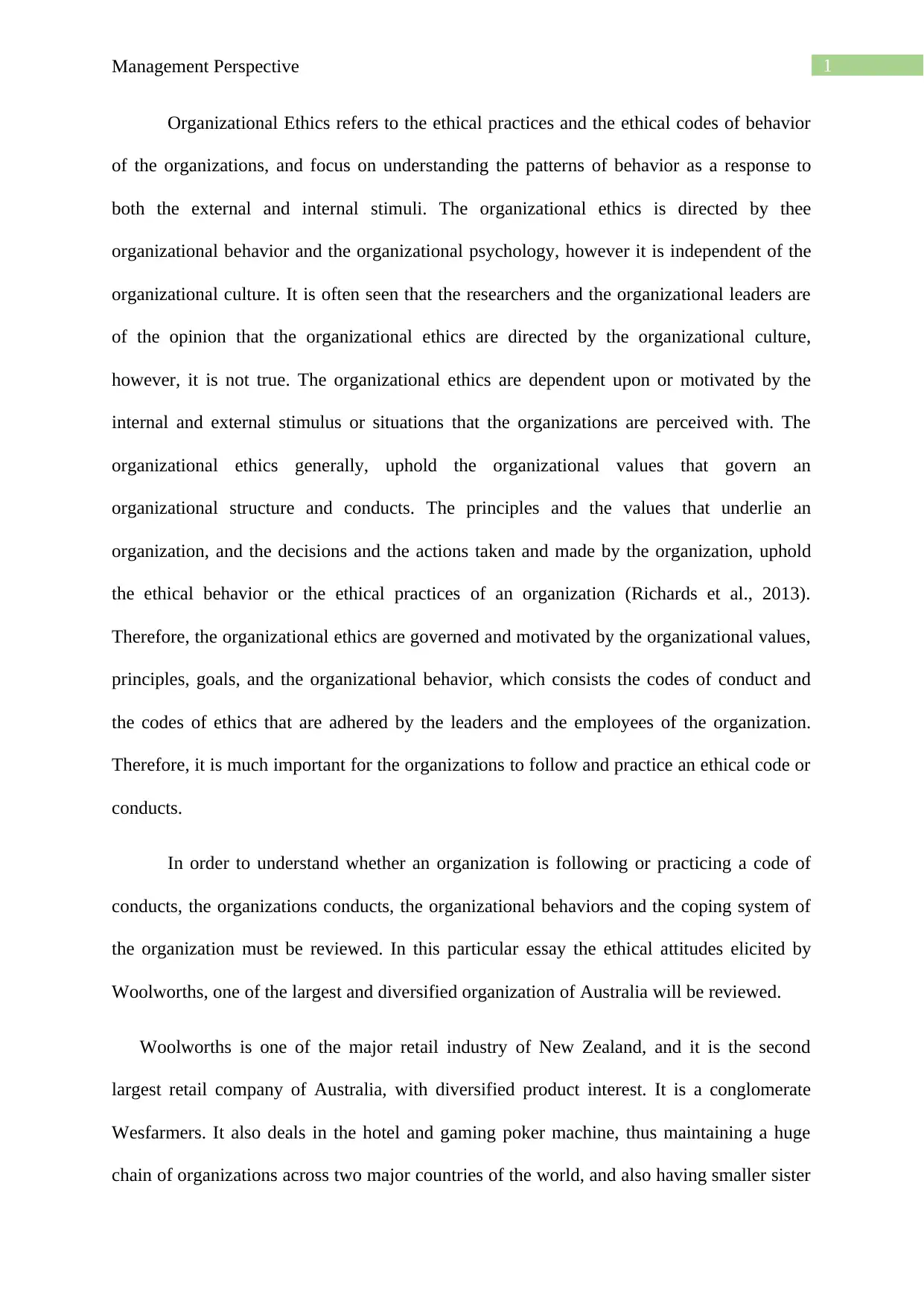
1Management Perspective
Organizational Ethics refers to the ethical practices and the ethical codes of behavior
of the organizations, and focus on understanding the patterns of behavior as a response to
both the external and internal stimuli. The organizational ethics is directed by thee
organizational behavior and the organizational psychology, however it is independent of the
organizational culture. It is often seen that the researchers and the organizational leaders are
of the opinion that the organizational ethics are directed by the organizational culture,
however, it is not true. The organizational ethics are dependent upon or motivated by the
internal and external stimulus or situations that the organizations are perceived with. The
organizational ethics generally, uphold the organizational values that govern an
organizational structure and conducts. The principles and the values that underlie an
organization, and the decisions and the actions taken and made by the organization, uphold
the ethical behavior or the ethical practices of an organization (Richards et al., 2013).
Therefore, the organizational ethics are governed and motivated by the organizational values,
principles, goals, and the organizational behavior, which consists the codes of conduct and
the codes of ethics that are adhered by the leaders and the employees of the organization.
Therefore, it is much important for the organizations to follow and practice an ethical code or
conducts.
In order to understand whether an organization is following or practicing a code of
conducts, the organizations conducts, the organizational behaviors and the coping system of
the organization must be reviewed. In this particular essay the ethical attitudes elicited by
Woolworths, one of the largest and diversified organization of Australia will be reviewed.
Woolworths is one of the major retail industry of New Zealand, and it is the second
largest retail company of Australia, with diversified product interest. It is a conglomerate
Wesfarmers. It also deals in the hotel and gaming poker machine, thus maintaining a huge
chain of organizations across two major countries of the world, and also having smaller sister
Organizational Ethics refers to the ethical practices and the ethical codes of behavior
of the organizations, and focus on understanding the patterns of behavior as a response to
both the external and internal stimuli. The organizational ethics is directed by thee
organizational behavior and the organizational psychology, however it is independent of the
organizational culture. It is often seen that the researchers and the organizational leaders are
of the opinion that the organizational ethics are directed by the organizational culture,
however, it is not true. The organizational ethics are dependent upon or motivated by the
internal and external stimulus or situations that the organizations are perceived with. The
organizational ethics generally, uphold the organizational values that govern an
organizational structure and conducts. The principles and the values that underlie an
organization, and the decisions and the actions taken and made by the organization, uphold
the ethical behavior or the ethical practices of an organization (Richards et al., 2013).
Therefore, the organizational ethics are governed and motivated by the organizational values,
principles, goals, and the organizational behavior, which consists the codes of conduct and
the codes of ethics that are adhered by the leaders and the employees of the organization.
Therefore, it is much important for the organizations to follow and practice an ethical code or
conducts.
In order to understand whether an organization is following or practicing a code of
conducts, the organizations conducts, the organizational behaviors and the coping system of
the organization must be reviewed. In this particular essay the ethical attitudes elicited by
Woolworths, one of the largest and diversified organization of Australia will be reviewed.
Woolworths is one of the major retail industry of New Zealand, and it is the second
largest retail company of Australia, with diversified product interest. It is a conglomerate
Wesfarmers. It also deals in the hotel and gaming poker machine, thus maintaining a huge
chain of organizations across two major countries of the world, and also having smaller sister
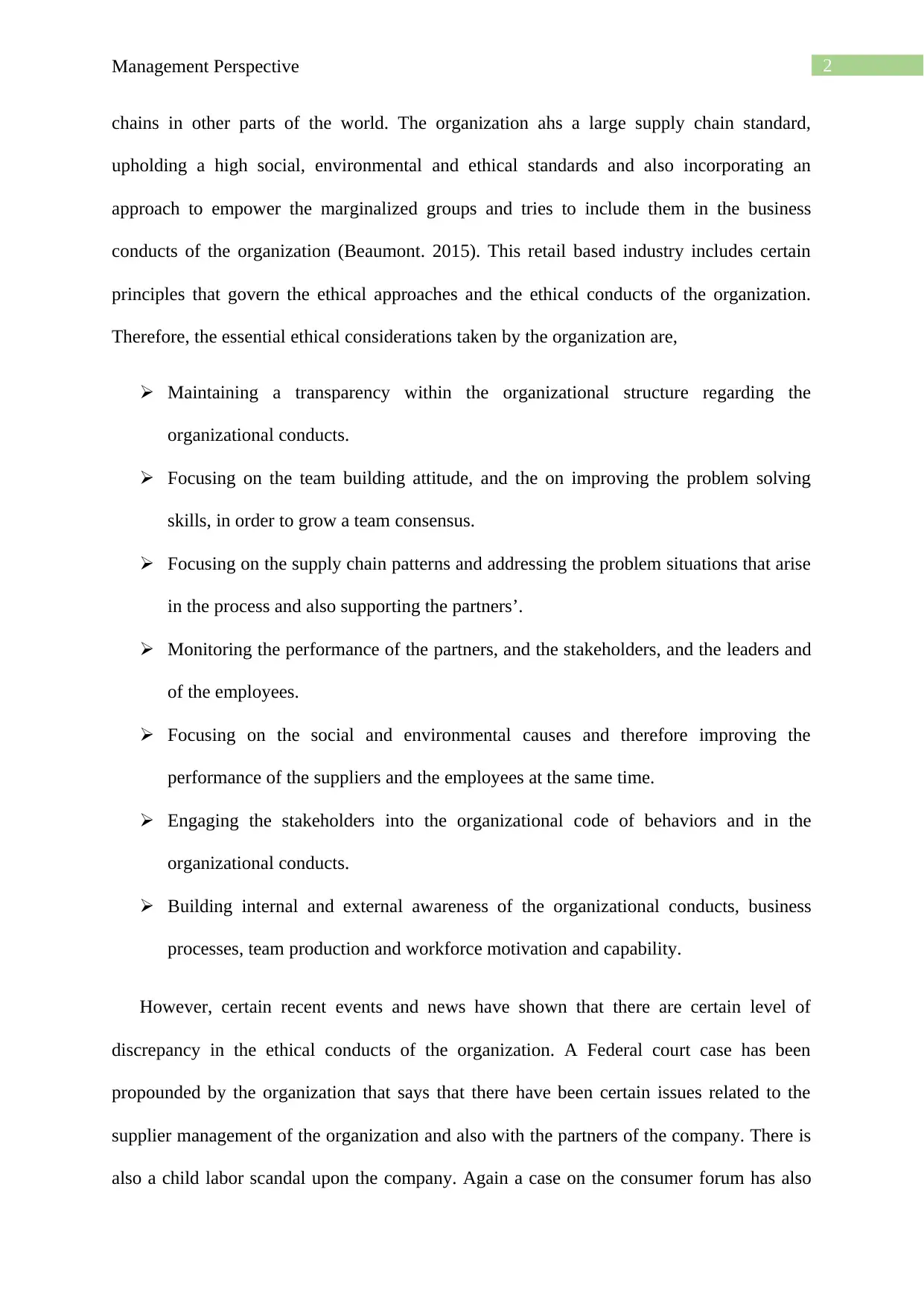
2Management Perspective
chains in other parts of the world. The organization ahs a large supply chain standard,
upholding a high social, environmental and ethical standards and also incorporating an
approach to empower the marginalized groups and tries to include them in the business
conducts of the organization (Beaumont. 2015). This retail based industry includes certain
principles that govern the ethical approaches and the ethical conducts of the organization.
Therefore, the essential ethical considerations taken by the organization are,
Maintaining a transparency within the organizational structure regarding the
organizational conducts.
Focusing on the team building attitude, and the on improving the problem solving
skills, in order to grow a team consensus.
Focusing on the supply chain patterns and addressing the problem situations that arise
in the process and also supporting the partners’.
Monitoring the performance of the partners, and the stakeholders, and the leaders and
of the employees.
Focusing on the social and environmental causes and therefore improving the
performance of the suppliers and the employees at the same time.
Engaging the stakeholders into the organizational code of behaviors and in the
organizational conducts.
Building internal and external awareness of the organizational conducts, business
processes, team production and workforce motivation and capability.
However, certain recent events and news have shown that there are certain level of
discrepancy in the ethical conducts of the organization. A Federal court case has been
propounded by the organization that says that there have been certain issues related to the
supplier management of the organization and also with the partners of the company. There is
also a child labor scandal upon the company. Again a case on the consumer forum has also
chains in other parts of the world. The organization ahs a large supply chain standard,
upholding a high social, environmental and ethical standards and also incorporating an
approach to empower the marginalized groups and tries to include them in the business
conducts of the organization (Beaumont. 2015). This retail based industry includes certain
principles that govern the ethical approaches and the ethical conducts of the organization.
Therefore, the essential ethical considerations taken by the organization are,
Maintaining a transparency within the organizational structure regarding the
organizational conducts.
Focusing on the team building attitude, and the on improving the problem solving
skills, in order to grow a team consensus.
Focusing on the supply chain patterns and addressing the problem situations that arise
in the process and also supporting the partners’.
Monitoring the performance of the partners, and the stakeholders, and the leaders and
of the employees.
Focusing on the social and environmental causes and therefore improving the
performance of the suppliers and the employees at the same time.
Engaging the stakeholders into the organizational code of behaviors and in the
organizational conducts.
Building internal and external awareness of the organizational conducts, business
processes, team production and workforce motivation and capability.
However, certain recent events and news have shown that there are certain level of
discrepancy in the ethical conducts of the organization. A Federal court case has been
propounded by the organization that says that there have been certain issues related to the
supplier management of the organization and also with the partners of the company. There is
also a child labor scandal upon the company. Again a case on the consumer forum has also
⊘ This is a preview!⊘
Do you want full access?
Subscribe today to unlock all pages.

Trusted by 1+ million students worldwide
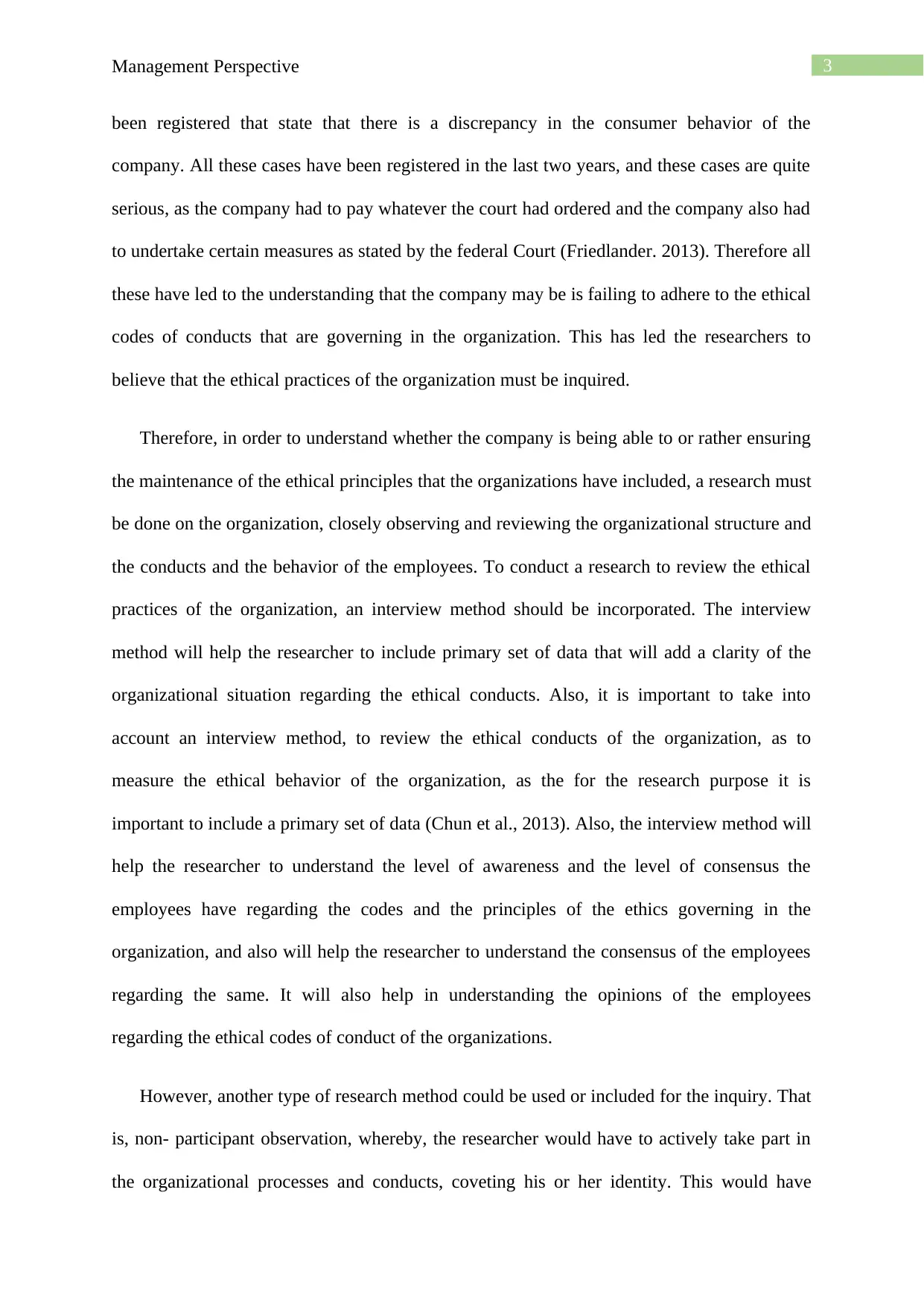
3Management Perspective
been registered that state that there is a discrepancy in the consumer behavior of the
company. All these cases have been registered in the last two years, and these cases are quite
serious, as the company had to pay whatever the court had ordered and the company also had
to undertake certain measures as stated by the federal Court (Friedlander. 2013). Therefore all
these have led to the understanding that the company may be is failing to adhere to the ethical
codes of conducts that are governing in the organization. This has led the researchers to
believe that the ethical practices of the organization must be inquired.
Therefore, in order to understand whether the company is being able to or rather ensuring
the maintenance of the ethical principles that the organizations have included, a research must
be done on the organization, closely observing and reviewing the organizational structure and
the conducts and the behavior of the employees. To conduct a research to review the ethical
practices of the organization, an interview method should be incorporated. The interview
method will help the researcher to include primary set of data that will add a clarity of the
organizational situation regarding the ethical conducts. Also, it is important to take into
account an interview method, to review the ethical conducts of the organization, as to
measure the ethical behavior of the organization, as the for the research purpose it is
important to include a primary set of data (Chun et al., 2013). Also, the interview method will
help the researcher to understand the level of awareness and the level of consensus the
employees have regarding the codes and the principles of the ethics governing in the
organization, and also will help the researcher to understand the consensus of the employees
regarding the same. It will also help in understanding the opinions of the employees
regarding the ethical codes of conduct of the organizations.
However, another type of research method could be used or included for the inquiry. That
is, non- participant observation, whereby, the researcher would have to actively take part in
the organizational processes and conducts, coveting his or her identity. This would have
been registered that state that there is a discrepancy in the consumer behavior of the
company. All these cases have been registered in the last two years, and these cases are quite
serious, as the company had to pay whatever the court had ordered and the company also had
to undertake certain measures as stated by the federal Court (Friedlander. 2013). Therefore all
these have led to the understanding that the company may be is failing to adhere to the ethical
codes of conducts that are governing in the organization. This has led the researchers to
believe that the ethical practices of the organization must be inquired.
Therefore, in order to understand whether the company is being able to or rather ensuring
the maintenance of the ethical principles that the organizations have included, a research must
be done on the organization, closely observing and reviewing the organizational structure and
the conducts and the behavior of the employees. To conduct a research to review the ethical
practices of the organization, an interview method should be incorporated. The interview
method will help the researcher to include primary set of data that will add a clarity of the
organizational situation regarding the ethical conducts. Also, it is important to take into
account an interview method, to review the ethical conducts of the organization, as to
measure the ethical behavior of the organization, as the for the research purpose it is
important to include a primary set of data (Chun et al., 2013). Also, the interview method will
help the researcher to understand the level of awareness and the level of consensus the
employees have regarding the codes and the principles of the ethics governing in the
organization, and also will help the researcher to understand the consensus of the employees
regarding the same. It will also help in understanding the opinions of the employees
regarding the ethical codes of conduct of the organizations.
However, another type of research method could be used or included for the inquiry. That
is, non- participant observation, whereby, the researcher would have to actively take part in
the organizational processes and conducts, coveting his or her identity. This would have
Paraphrase This Document
Need a fresh take? Get an instant paraphrase of this document with our AI Paraphraser
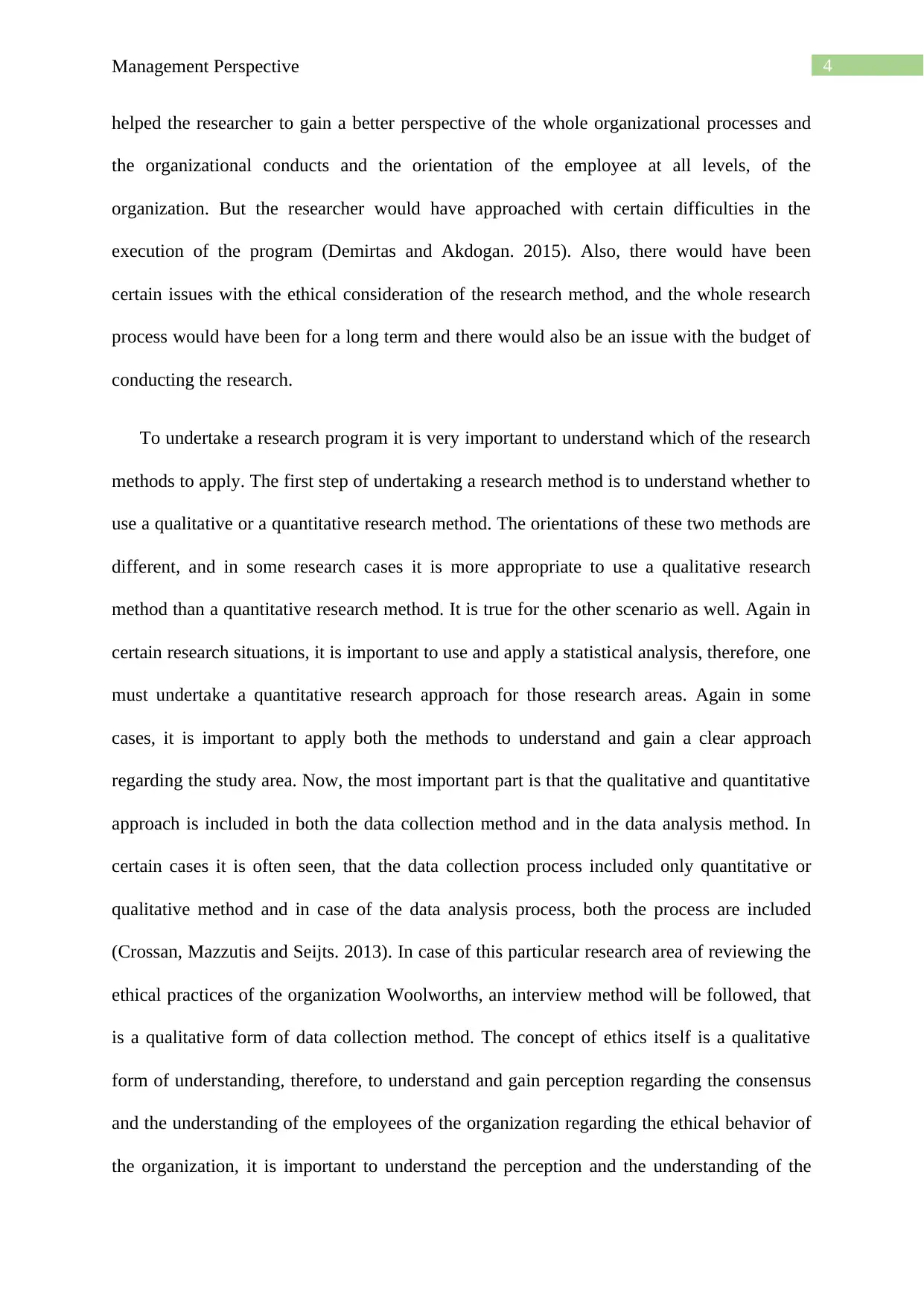
4Management Perspective
helped the researcher to gain a better perspective of the whole organizational processes and
the organizational conducts and the orientation of the employee at all levels, of the
organization. But the researcher would have approached with certain difficulties in the
execution of the program (Demirtas and Akdogan. 2015). Also, there would have been
certain issues with the ethical consideration of the research method, and the whole research
process would have been for a long term and there would also be an issue with the budget of
conducting the research.
To undertake a research program it is very important to understand which of the research
methods to apply. The first step of undertaking a research method is to understand whether to
use a qualitative or a quantitative research method. The orientations of these two methods are
different, and in some research cases it is more appropriate to use a qualitative research
method than a quantitative research method. It is true for the other scenario as well. Again in
certain research situations, it is important to use and apply a statistical analysis, therefore, one
must undertake a quantitative research approach for those research areas. Again in some
cases, it is important to apply both the methods to understand and gain a clear approach
regarding the study area. Now, the most important part is that the qualitative and quantitative
approach is included in both the data collection method and in the data analysis method. In
certain cases it is often seen, that the data collection process included only quantitative or
qualitative method and in case of the data analysis process, both the process are included
(Crossan, Mazzutis and Seijts. 2013). In case of this particular research area of reviewing the
ethical practices of the organization Woolworths, an interview method will be followed, that
is a qualitative form of data collection method. The concept of ethics itself is a qualitative
form of understanding, therefore, to understand and gain perception regarding the consensus
and the understanding of the employees of the organization regarding the ethical behavior of
the organization, it is important to understand the perception and the understanding of the
helped the researcher to gain a better perspective of the whole organizational processes and
the organizational conducts and the orientation of the employee at all levels, of the
organization. But the researcher would have approached with certain difficulties in the
execution of the program (Demirtas and Akdogan. 2015). Also, there would have been
certain issues with the ethical consideration of the research method, and the whole research
process would have been for a long term and there would also be an issue with the budget of
conducting the research.
To undertake a research program it is very important to understand which of the research
methods to apply. The first step of undertaking a research method is to understand whether to
use a qualitative or a quantitative research method. The orientations of these two methods are
different, and in some research cases it is more appropriate to use a qualitative research
method than a quantitative research method. It is true for the other scenario as well. Again in
certain research situations, it is important to use and apply a statistical analysis, therefore, one
must undertake a quantitative research approach for those research areas. Again in some
cases, it is important to apply both the methods to understand and gain a clear approach
regarding the study area. Now, the most important part is that the qualitative and quantitative
approach is included in both the data collection method and in the data analysis method. In
certain cases it is often seen, that the data collection process included only quantitative or
qualitative method and in case of the data analysis process, both the process are included
(Crossan, Mazzutis and Seijts. 2013). In case of this particular research area of reviewing the
ethical practices of the organization Woolworths, an interview method will be followed, that
is a qualitative form of data collection method. The concept of ethics itself is a qualitative
form of understanding, therefore, to understand and gain perception regarding the consensus
and the understanding of the employees of the organization regarding the ethical behavior of
the organization, it is important to understand the perception and the understanding of the
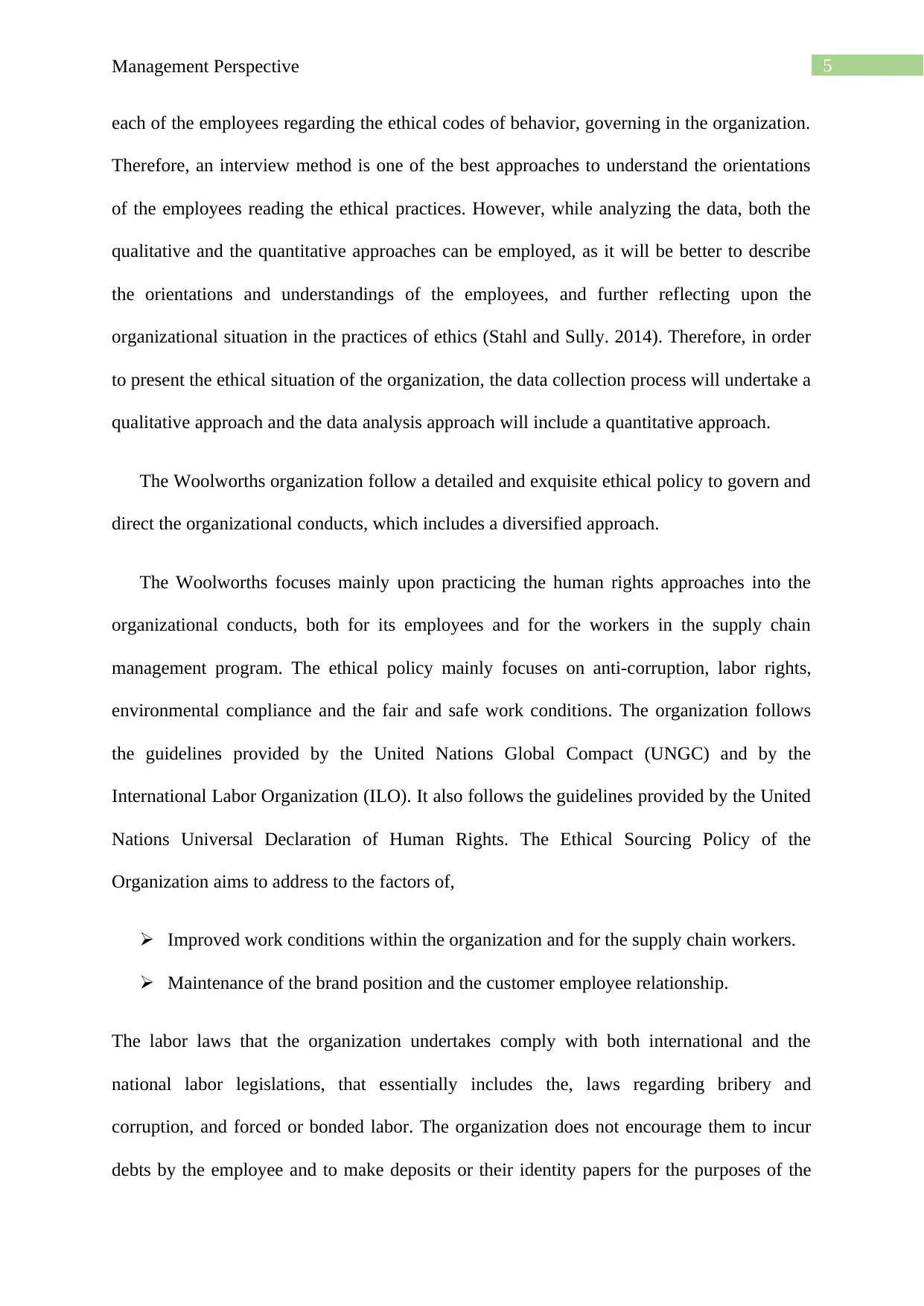
5Management Perspective
each of the employees regarding the ethical codes of behavior, governing in the organization.
Therefore, an interview method is one of the best approaches to understand the orientations
of the employees reading the ethical practices. However, while analyzing the data, both the
qualitative and the quantitative approaches can be employed, as it will be better to describe
the orientations and understandings of the employees, and further reflecting upon the
organizational situation in the practices of ethics (Stahl and Sully. 2014). Therefore, in order
to present the ethical situation of the organization, the data collection process will undertake a
qualitative approach and the data analysis approach will include a quantitative approach.
The Woolworths organization follow a detailed and exquisite ethical policy to govern and
direct the organizational conducts, which includes a diversified approach.
The Woolworths focuses mainly upon practicing the human rights approaches into the
organizational conducts, both for its employees and for the workers in the supply chain
management program. The ethical policy mainly focuses on anti-corruption, labor rights,
environmental compliance and the fair and safe work conditions. The organization follows
the guidelines provided by the United Nations Global Compact (UNGC) and by the
International Labor Organization (ILO). It also follows the guidelines provided by the United
Nations Universal Declaration of Human Rights. The Ethical Sourcing Policy of the
Organization aims to address to the factors of,
Improved work conditions within the organization and for the supply chain workers.
Maintenance of the brand position and the customer employee relationship.
The labor laws that the organization undertakes comply with both international and the
national labor legislations, that essentially includes the, laws regarding bribery and
corruption, and forced or bonded labor. The organization does not encourage them to incur
debts by the employee and to make deposits or their identity papers for the purposes of the
each of the employees regarding the ethical codes of behavior, governing in the organization.
Therefore, an interview method is one of the best approaches to understand the orientations
of the employees reading the ethical practices. However, while analyzing the data, both the
qualitative and the quantitative approaches can be employed, as it will be better to describe
the orientations and understandings of the employees, and further reflecting upon the
organizational situation in the practices of ethics (Stahl and Sully. 2014). Therefore, in order
to present the ethical situation of the organization, the data collection process will undertake a
qualitative approach and the data analysis approach will include a quantitative approach.
The Woolworths organization follow a detailed and exquisite ethical policy to govern and
direct the organizational conducts, which includes a diversified approach.
The Woolworths focuses mainly upon practicing the human rights approaches into the
organizational conducts, both for its employees and for the workers in the supply chain
management program. The ethical policy mainly focuses on anti-corruption, labor rights,
environmental compliance and the fair and safe work conditions. The organization follows
the guidelines provided by the United Nations Global Compact (UNGC) and by the
International Labor Organization (ILO). It also follows the guidelines provided by the United
Nations Universal Declaration of Human Rights. The Ethical Sourcing Policy of the
Organization aims to address to the factors of,
Improved work conditions within the organization and for the supply chain workers.
Maintenance of the brand position and the customer employee relationship.
The labor laws that the organization undertakes comply with both international and the
national labor legislations, that essentially includes the, laws regarding bribery and
corruption, and forced or bonded labor. The organization does not encourage them to incur
debts by the employee and to make deposits or their identity papers for the purposes of the
⊘ This is a preview!⊘
Do you want full access?
Subscribe today to unlock all pages.

Trusted by 1+ million students worldwide
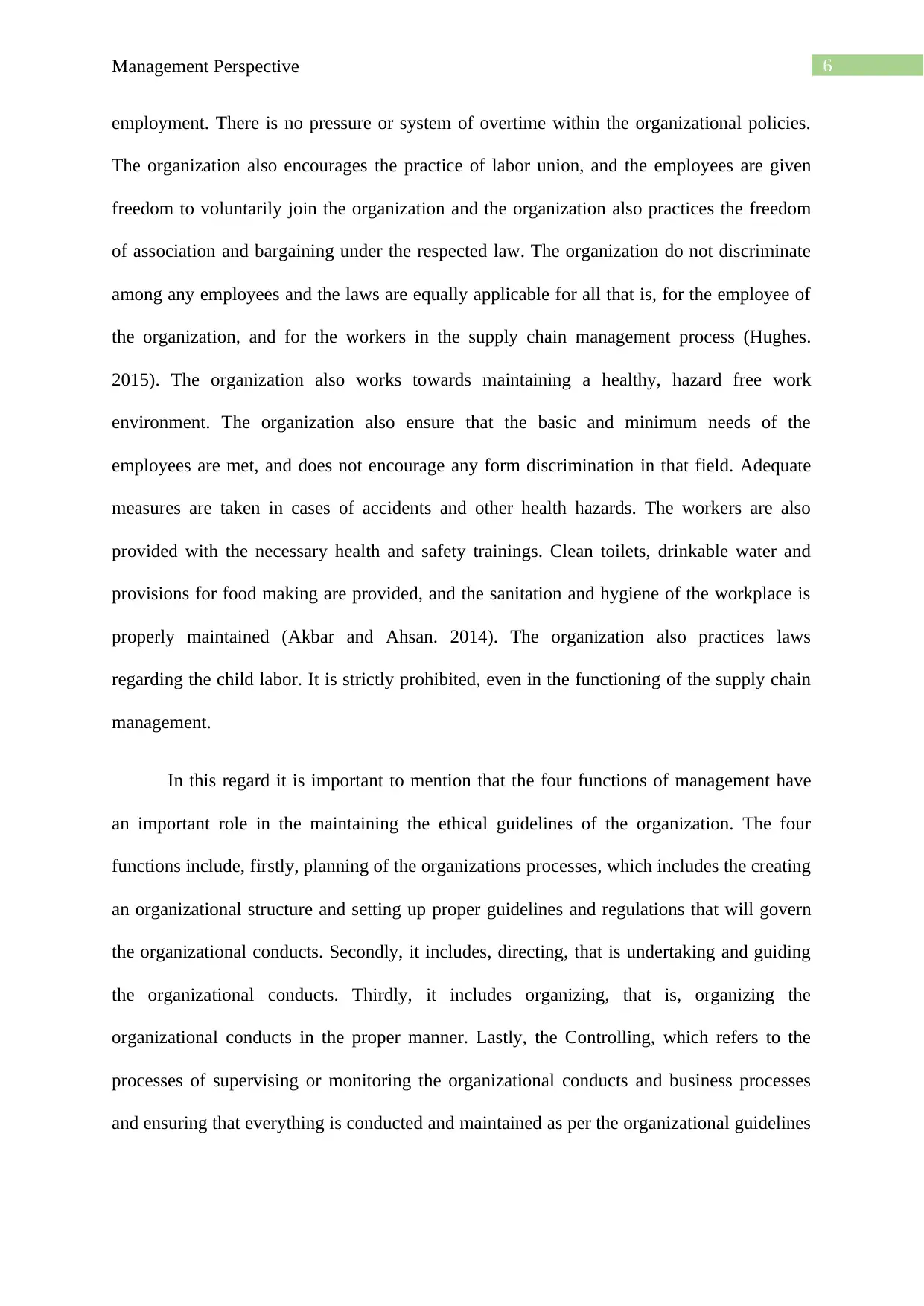
6Management Perspective
employment. There is no pressure or system of overtime within the organizational policies.
The organization also encourages the practice of labor union, and the employees are given
freedom to voluntarily join the organization and the organization also practices the freedom
of association and bargaining under the respected law. The organization do not discriminate
among any employees and the laws are equally applicable for all that is, for the employee of
the organization, and for the workers in the supply chain management process (Hughes.
2015). The organization also works towards maintaining a healthy, hazard free work
environment. The organization also ensure that the basic and minimum needs of the
employees are met, and does not encourage any form discrimination in that field. Adequate
measures are taken in cases of accidents and other health hazards. The workers are also
provided with the necessary health and safety trainings. Clean toilets, drinkable water and
provisions for food making are provided, and the sanitation and hygiene of the workplace is
properly maintained (Akbar and Ahsan. 2014). The organization also practices laws
regarding the child labor. It is strictly prohibited, even in the functioning of the supply chain
management.
In this regard it is important to mention that the four functions of management have
an important role in the maintaining the ethical guidelines of the organization. The four
functions include, firstly, planning of the organizations processes, which includes the creating
an organizational structure and setting up proper guidelines and regulations that will govern
the organizational conducts. Secondly, it includes, directing, that is undertaking and guiding
the organizational conducts. Thirdly, it includes organizing, that is, organizing the
organizational conducts in the proper manner. Lastly, the Controlling, which refers to the
processes of supervising or monitoring the organizational conducts and business processes
and ensuring that everything is conducted and maintained as per the organizational guidelines
employment. There is no pressure or system of overtime within the organizational policies.
The organization also encourages the practice of labor union, and the employees are given
freedom to voluntarily join the organization and the organization also practices the freedom
of association and bargaining under the respected law. The organization do not discriminate
among any employees and the laws are equally applicable for all that is, for the employee of
the organization, and for the workers in the supply chain management process (Hughes.
2015). The organization also works towards maintaining a healthy, hazard free work
environment. The organization also ensure that the basic and minimum needs of the
employees are met, and does not encourage any form discrimination in that field. Adequate
measures are taken in cases of accidents and other health hazards. The workers are also
provided with the necessary health and safety trainings. Clean toilets, drinkable water and
provisions for food making are provided, and the sanitation and hygiene of the workplace is
properly maintained (Akbar and Ahsan. 2014). The organization also practices laws
regarding the child labor. It is strictly prohibited, even in the functioning of the supply chain
management.
In this regard it is important to mention that the four functions of management have
an important role in the maintaining the ethical guidelines of the organization. The four
functions include, firstly, planning of the organizations processes, which includes the creating
an organizational structure and setting up proper guidelines and regulations that will govern
the organizational conducts. Secondly, it includes, directing, that is undertaking and guiding
the organizational conducts. Thirdly, it includes organizing, that is, organizing the
organizational conducts in the proper manner. Lastly, the Controlling, which refers to the
processes of supervising or monitoring the organizational conducts and business processes
and ensuring that everything is conducted and maintained as per the organizational guidelines
Paraphrase This Document
Need a fresh take? Get an instant paraphrase of this document with our AI Paraphraser
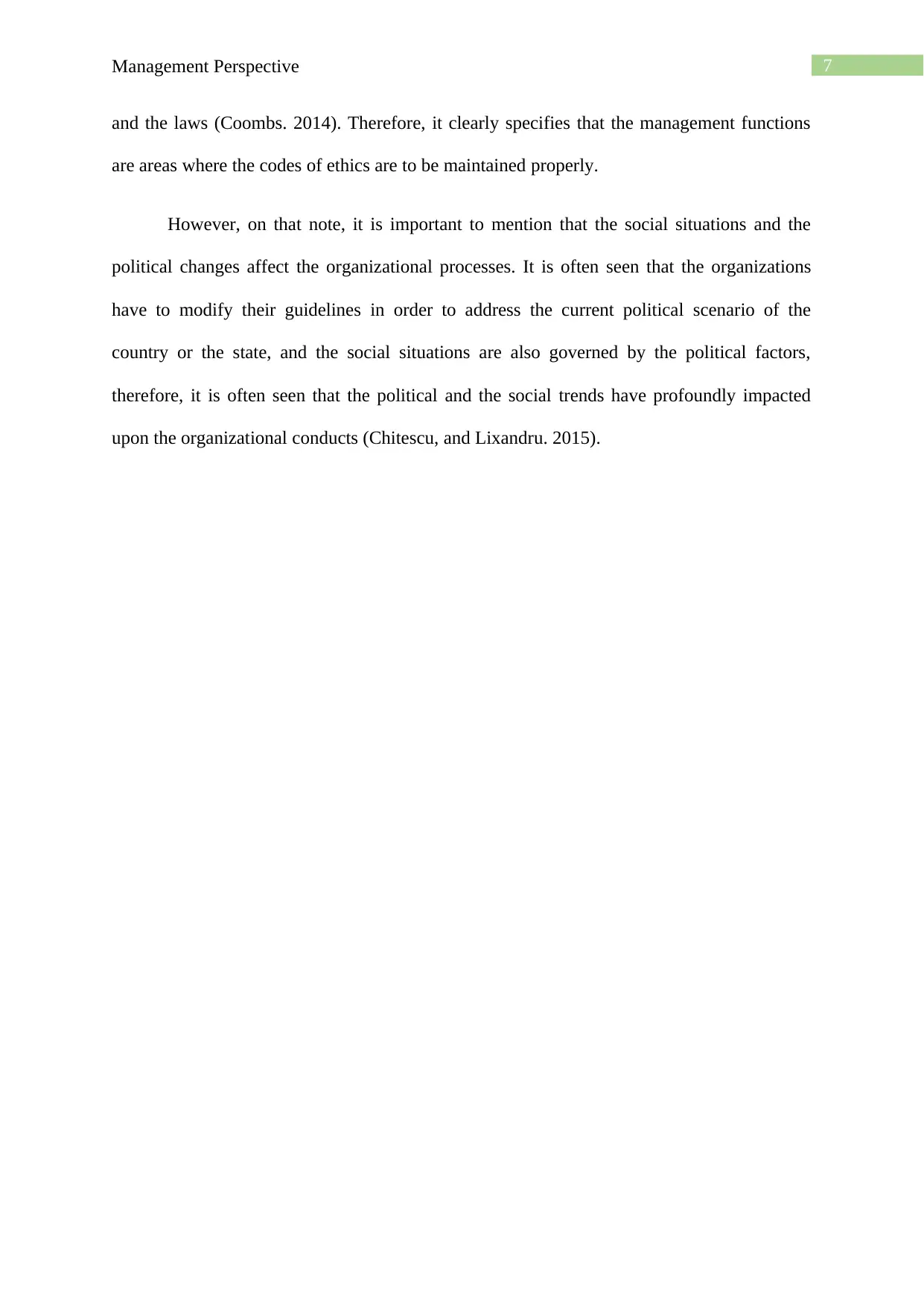
7Management Perspective
and the laws (Coombs. 2014). Therefore, it clearly specifies that the management functions
are areas where the codes of ethics are to be maintained properly.
However, on that note, it is important to mention that the social situations and the
political changes affect the organizational processes. It is often seen that the organizations
have to modify their guidelines in order to address the current political scenario of the
country or the state, and the social situations are also governed by the political factors,
therefore, it is often seen that the political and the social trends have profoundly impacted
upon the organizational conducts (Chitescu, and Lixandru. 2015).
and the laws (Coombs. 2014). Therefore, it clearly specifies that the management functions
are areas where the codes of ethics are to be maintained properly.
However, on that note, it is important to mention that the social situations and the
political changes affect the organizational processes. It is often seen that the organizations
have to modify their guidelines in order to address the current political scenario of the
country or the state, and the social situations are also governed by the political factors,
therefore, it is often seen that the political and the social trends have profoundly impacted
upon the organizational conducts (Chitescu, and Lixandru. 2015).
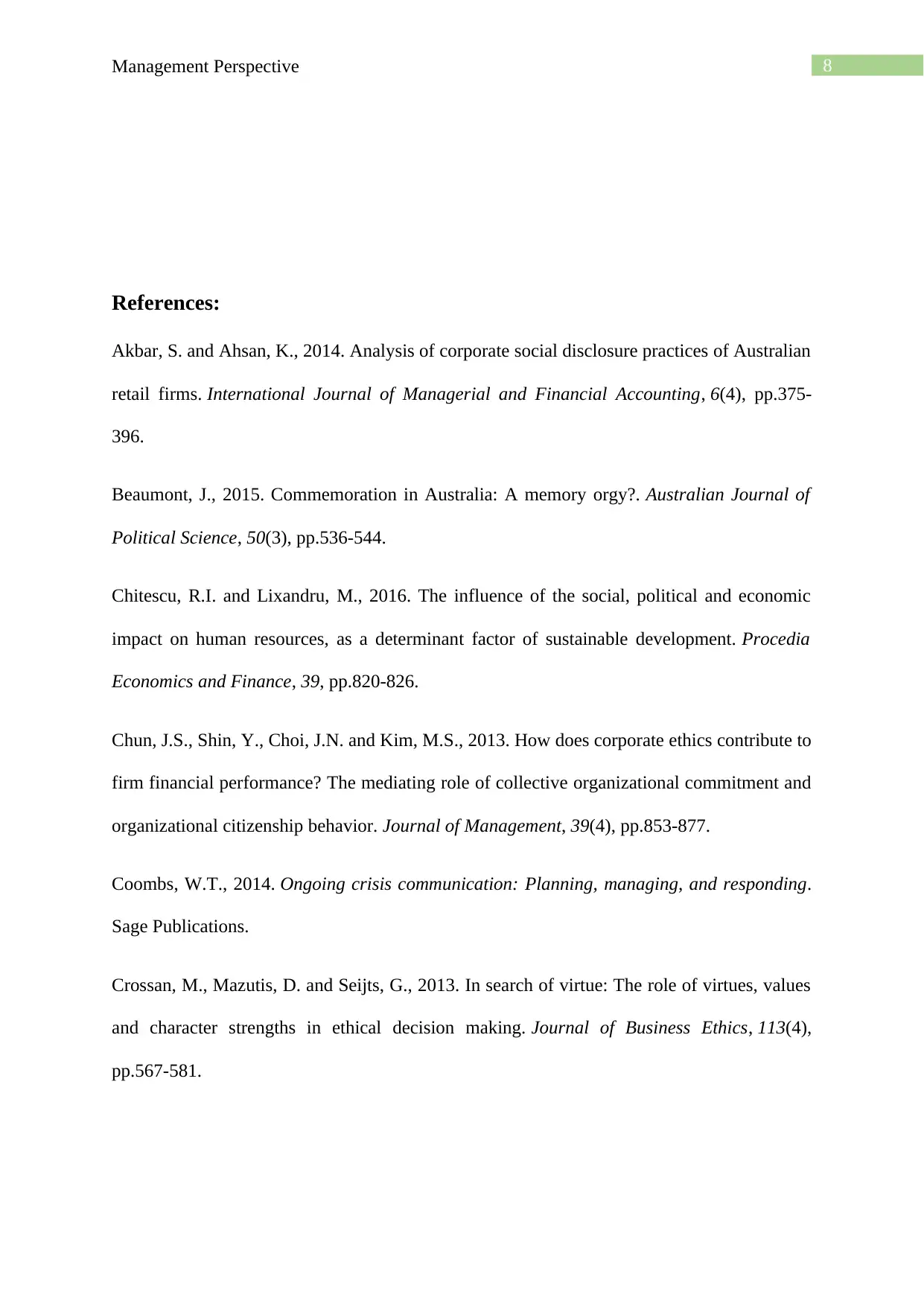
8Management Perspective
References:
Akbar, S. and Ahsan, K., 2014. Analysis of corporate social disclosure practices of Australian
retail firms. International Journal of Managerial and Financial Accounting, 6(4), pp.375-
396.
Beaumont, J., 2015. Commemoration in Australia: A memory orgy?. Australian Journal of
Political Science, 50(3), pp.536-544.
Chitescu, R.I. and Lixandru, M., 2016. The influence of the social, political and economic
impact on human resources, as a determinant factor of sustainable development. Procedia
Economics and Finance, 39, pp.820-826.
Chun, J.S., Shin, Y., Choi, J.N. and Kim, M.S., 2013. How does corporate ethics contribute to
firm financial performance? The mediating role of collective organizational commitment and
organizational citizenship behavior. Journal of Management, 39(4), pp.853-877.
Coombs, W.T., 2014. Ongoing crisis communication: Planning, managing, and responding.
Sage Publications.
Crossan, M., Mazutis, D. and Seijts, G., 2013. In search of virtue: The role of virtues, values
and character strengths in ethical decision making. Journal of Business Ethics, 113(4),
pp.567-581.
References:
Akbar, S. and Ahsan, K., 2014. Analysis of corporate social disclosure practices of Australian
retail firms. International Journal of Managerial and Financial Accounting, 6(4), pp.375-
396.
Beaumont, J., 2015. Commemoration in Australia: A memory orgy?. Australian Journal of
Political Science, 50(3), pp.536-544.
Chitescu, R.I. and Lixandru, M., 2016. The influence of the social, political and economic
impact on human resources, as a determinant factor of sustainable development. Procedia
Economics and Finance, 39, pp.820-826.
Chun, J.S., Shin, Y., Choi, J.N. and Kim, M.S., 2013. How does corporate ethics contribute to
firm financial performance? The mediating role of collective organizational commitment and
organizational citizenship behavior. Journal of Management, 39(4), pp.853-877.
Coombs, W.T., 2014. Ongoing crisis communication: Planning, managing, and responding.
Sage Publications.
Crossan, M., Mazutis, D. and Seijts, G., 2013. In search of virtue: The role of virtues, values
and character strengths in ethical decision making. Journal of Business Ethics, 113(4),
pp.567-581.
⊘ This is a preview!⊘
Do you want full access?
Subscribe today to unlock all pages.

Trusted by 1+ million students worldwide
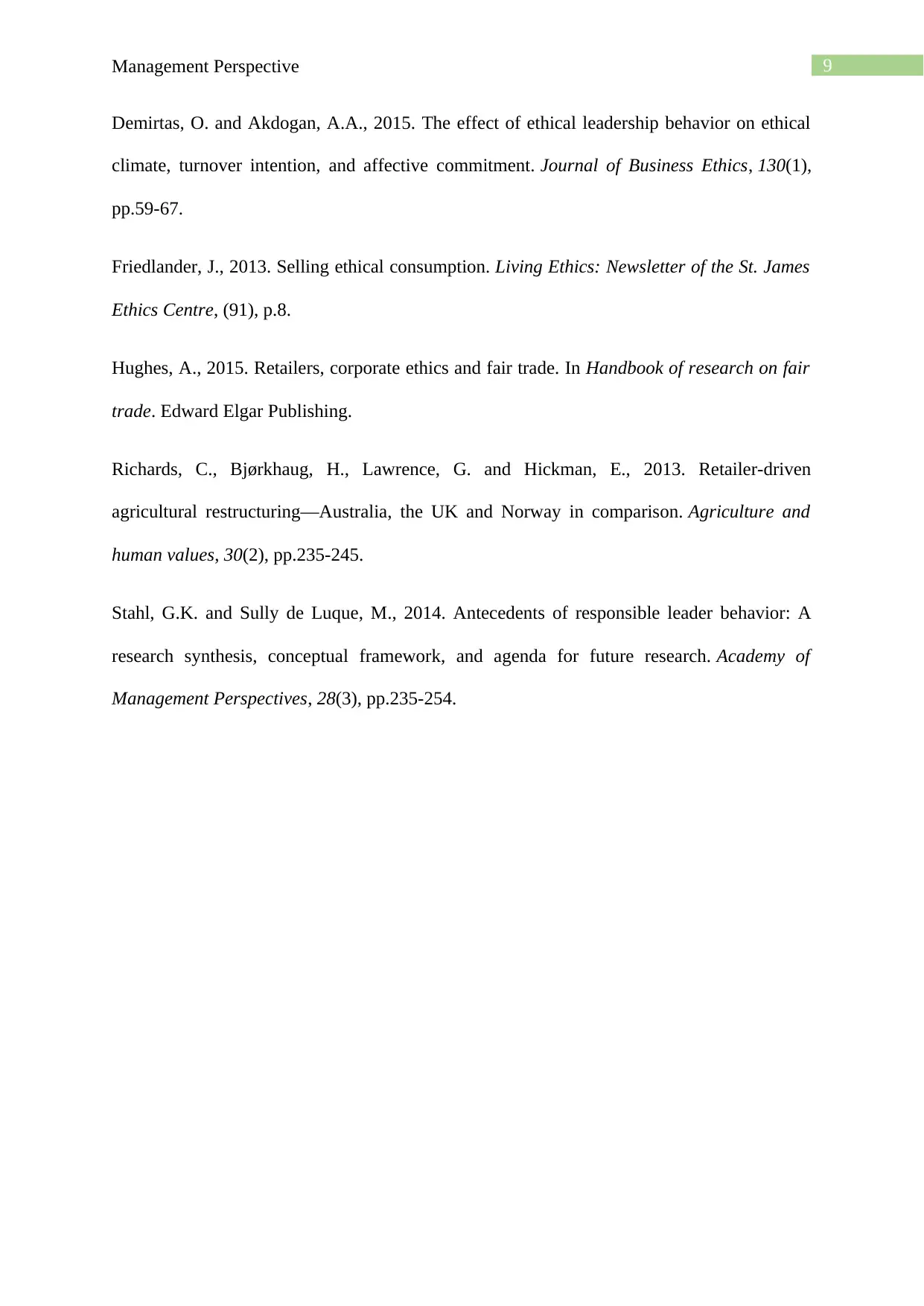
9Management Perspective
Demirtas, O. and Akdogan, A.A., 2015. The effect of ethical leadership behavior on ethical
climate, turnover intention, and affective commitment. Journal of Business Ethics, 130(1),
pp.59-67.
Friedlander, J., 2013. Selling ethical consumption. Living Ethics: Newsletter of the St. James
Ethics Centre, (91), p.8.
Hughes, A., 2015. Retailers, corporate ethics and fair trade. In Handbook of research on fair
trade. Edward Elgar Publishing.
Richards, C., Bjørkhaug, H., Lawrence, G. and Hickman, E., 2013. Retailer-driven
agricultural restructuring—Australia, the UK and Norway in comparison. Agriculture and
human values, 30(2), pp.235-245.
Stahl, G.K. and Sully de Luque, M., 2014. Antecedents of responsible leader behavior: A
research synthesis, conceptual framework, and agenda for future research. Academy of
Management Perspectives, 28(3), pp.235-254.
Demirtas, O. and Akdogan, A.A., 2015. The effect of ethical leadership behavior on ethical
climate, turnover intention, and affective commitment. Journal of Business Ethics, 130(1),
pp.59-67.
Friedlander, J., 2013. Selling ethical consumption. Living Ethics: Newsletter of the St. James
Ethics Centre, (91), p.8.
Hughes, A., 2015. Retailers, corporate ethics and fair trade. In Handbook of research on fair
trade. Edward Elgar Publishing.
Richards, C., Bjørkhaug, H., Lawrence, G. and Hickman, E., 2013. Retailer-driven
agricultural restructuring—Australia, the UK and Norway in comparison. Agriculture and
human values, 30(2), pp.235-245.
Stahl, G.K. and Sully de Luque, M., 2014. Antecedents of responsible leader behavior: A
research synthesis, conceptual framework, and agenda for future research. Academy of
Management Perspectives, 28(3), pp.235-254.
1 out of 10
Related Documents
Your All-in-One AI-Powered Toolkit for Academic Success.
+13062052269
info@desklib.com
Available 24*7 on WhatsApp / Email
![[object Object]](/_next/static/media/star-bottom.7253800d.svg)
Unlock your academic potential
Copyright © 2020–2025 A2Z Services. All Rights Reserved. Developed and managed by ZUCOL.





